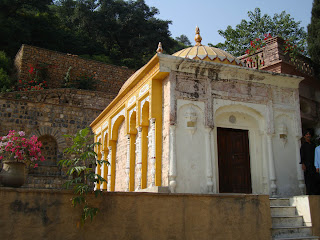Saidpur - A Model village in Islamabad.
Shoot & Edited by RebelDesigner using Sony W300 Compact camera, Edited in After Effects.
Special Features: Apart from showing saidpur village, my elder brother is also visible in movie at few places. In the beginning of the movie you'll be listening one of my favorite raag track but after half of the movie the original track of movie can be heard where theres a person playing Rubab (a traditional Pakistani music instrument) siting right there.




Saidpur is a very old village — 4 or 5 hundred years old — with a history and heritage and, of course, its own myths and folklore. It is nestled in the Margallah hills overlooking Islamabad. Built along the slope of the hills, and gradually creeping upwards, the village presents a picturesque view, particularly in the soft light of morning or afternoon sun.
Saidpur is named after Said Khan, the son of Sultan Sarang Khan, the Gakhar chief of the Potohar region during Emperor Baburs time. Emperor Jahangirs memoir, Tuzke Jahangiri, mentions Jahangir halting at a place beyond Rawalpindi, on his way to Kabul. From his description it seems the place was Saidpur.




According to Fauzia Minallah: The Persian book Kaigor Namah beautifully describes the place [Saidpur] during the visit of the Mughal commander Raja Man Singh in about 1580. It was a garden resort with a number of natural streams supplying water for drinking and irrigation. Raja Man Singh was so enamored by the village that he turned it into a place of religious worship. He constructed raised platforms, walled enclosures and a number of kunds (ponds) called Rama kunda, Sita kunda, Lakshaman kunda and Hanuman kunda named after the characters of the Hindu epic Ramayana. Saidpur was declared a pilgrim center and Rama kunda was preserved right up to 1947.




The first thing you notice when you enter the village (and that is a big surprise), past a green domed mosque, is a Hindu temple, prominently situated and newly restored and painted. A little removed from the temple, to the left, is a small building with two orange colored domes. A plaque on this building, written in what appears to be Gurmukhi, suggests it might have been a gurdwara or a Sikh shrine. Between the temple and the gurdwara is a neat, 2-storey building that was an orphanage (dharamsala) at one time. The temple is mentioned in the Punjab Gazetteer of Rawalpindi district of 1893-94, which suggests it is over a hundred years old. Its amazing that a temple and gurdwara survived in a village that had no Hindu or Sikh population since 1947.





The secret of survival of the temple and the attached buildings, I found, was that soon after the Partition they were converted into a government school, and thus saved from being vandalized. Only recently the school was shifted and the temple and the gurdwara renovated in their original form (a little overdone, though), and the orphanage was converted into a gallery where old photographs of Islamabad, when it was just being built, are displayed.




Saidpur is also known for making unglazed pottery. According to Fauzia Minallah, The distinct cultural identity of Saidpur has always been its pottery and it has always been known as the potters village. She also mentions two old potters of the village, Niaz Muhammad and Rahim Dad, who still run their workshops in the village.
Among other things, you'll find shrine of Zinda Pir or the Living Saint, which is located just a couple of hundred feet above the temple on the hill slope under a pair of old banyan trees. It is been said that this Zinda Pir was actually Khawaja Khizar.




According to some Muslim traditions, Khizar or Khidar, having drunk from Aab-i-Hayat or the fountain of life attained immortality and roams the earth incognito, usually along riverbanks, lakes and mountain streams. Some also believe him to be a prophet. He is believed to help people who have lost their way. In Urdu poetry, Khizar is often used as a metaphor for a person who guides lost people. Khwaja Pir/Khwaja Khizr is been worshiped in Punjab, India by many from generations.
info taken from:http://pakistaniat.com/2008/03/24/sia...
will upload more about Qila Katas Raj, Qila Rohtaas, Pir Sohawa, etc...
Thank you for viewing, please dont forget to comment...
RebelDesigner
No comments:
Post a Comment